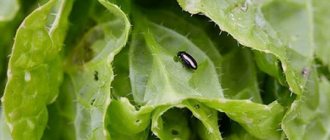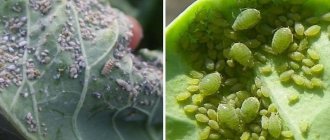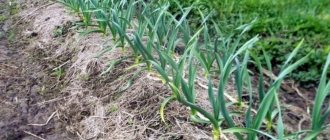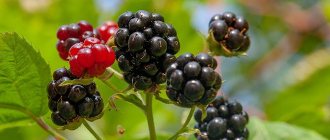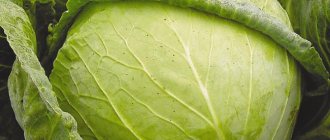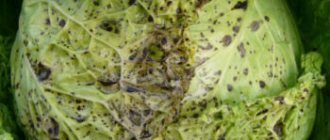It is important for every gardener to know how to get rid of slugs on cabbage, because these pests can eat all the seedlings in a short time. In addition, mollusks pose another danger - pathogenic microbes penetrate into the damage left on the leaves. There are many ways to protect yourself from these uninvited guests; several are worth adopting and using so that the harvest does not suffer.
Cabbage damaged by slugs
Signs of cabbage being damaged by slugs
Gastropods, despite the lack of a shell, are very tenacious and hardy. During the daytime, slugs are almost impossible to see on the site, because they hide from sunlight in dark and damp places: in weeds, under the top leaves of cabbage.
Late in the evening, pests crawl out of hiding and feast on tender young cabbage leaves until the morning. They are especially active in rainy weather when air humidity is high.
It is easy for experienced gardeners to detect the pest and recognize it by holes of different sizes on the leaves. The voracious mollusks leave behind a trail of mucus. It protects the body from drying out and helps the pest move. As the mucus dries, it acquires a silvery tint, which is clearly visible on cabbage leaves.
Attention! If you examine the heads of cabbage, you can find the passages that pests make in them.
Damage caused
Slugs are large pests that, in the absence of special treatment, can destroy the entire cabbage crop. However, the degree of damage depends not only on their size, but also on their number.
Mollusks are endowed with powerful jaws, so they destroy plantings with great speed. They do not eat the entire head of cabbage, but damage it so much that it becomes unsuitable for consumption or further storage. This pest attacks all types of cabbage: white cabbage, broccoli, Peking cabbage, cauliflower, Brussels sprouts.
Reference. Red cabbage suffers less from slug infestations than other varieties.
In addition to the fact that pests eat the succulent shoots of the plant, they spread fungal infections and other diseases that affect the volume of the harvest. Their saliva contains a special enzyme, which causes the leaves of the vegetable to become covered with dark spots, after which signs of rot appear.
Sometimes the damage caused by diseases is greater than that caused by mechanical damage from slugs.
Folk remedies for killing slugs
Our great-grandmothers successfully used affordable and safe means for humans to protect plants from mollusks:
- wood ash;
- vinegar solution;
- mustard;
- ammonia;
- tobacco dust.
Ammonia
Stove ash is used to dust cabbage and the soil under the plants. To spray the beds, prepare an ash-soap solution. To do this, dissolve a glass of ash in 10 liters of water, add shavings of half a piece of laundry soap.
Slugs will not stay on cabbage if you use vinegar. You need to dilute 200 ml in 10 liters of water and water the plants. 9% table vinegar can be replaced with 2 tbsp. l. essences. Acid has a detrimental effect on the delicate bodies of mollusks. If they get burned, they will die.
A good remedy for slugs is ammonia. You will need 1 bottle of the substance and 10 liters of water. Add 100 g of mustard powder to the resulting liquid. The solution is used to spray the above-ground parts of plants.
Mustard will help get rid of slugs even faster if you mix the dry powder with ground red pepper and dust the plantings. Pests will die if there is a hot spice on their bodies.
Tobacco dust has proven itself not only against slugs on cabbage, but also against other insects that feed on the sap and greens of plants. Gardeners crush the leaves with it and sprinkle the soil under the bushes.
Ways to get rid of slugs on cabbage
To protect cabbage from slugs, various methods are used. Folk remedies are considered the safest, but chemicals are the most effective.
Chemicals
The easiest way is to use chemicals to control slugs. The main active ingredient of such drugs is metaldehyde. Solid, insoluble granules act upon contact and ingestion.
The most common chemical repellents for slugs:
- " Meta ". Has a contact-intestinal effect. This drug is produced in dry form. After the granules are scattered in the space between the rows, the slugs begin to group under the leaves of the cabbage heads and die there. Meta is also produced in powder form. They powder heads of cabbage with it for prevention. The drug is used no later than 3 weeks before harvesting cabbage from the beds.
- "Ulicide." The product is made on the basis of iron phosphate salt. It is considered not as toxic to people and animals as the previous one. When the active substance enters the pest’s body, it causes very rapid dehydration. The slug dies within 40 minutes. This product is used no more than 2 times during the entire season.
- "Ecokiller". A natural preparation, which is made on the basis of diatomite, in powder form. It also has a dehydrating effect on pests. At the same time, Ecokiller is not dangerous for people and animals. For 1 sq. m scatter 20 g of powder.
- "Slug eater." The product is produced in the form of granules. In 3-4 days it causes the death of the slug population. For 10 sq. m of beds use 30 g of the drug.
When using chemicals against pests, it is advisable to use personal protective equipment: gloves, a face mask and clothing made of thick fabric.
Traditional methods
Often gardeners prefer to use traditional methods of pest control. Ingredients for cooking are always available.
The most common means:
- Coffee solution. Both ground and instant coffee are used for spraying. The drink is made very strong. After cooling, spray the heads of cabbage and the space between them.
- A solution of ammonia. To combat slugs, a solution is often used, which is prepared from 1 part ammonia and 6 parts water. Spraying helps effectively control pests, but does not harm cabbage. The main thing is to use this method no more than once a week, so as not to cause the vegetables to dry out.
Agrotechnical techniques
Many summer residents create a kind of obstacle course that prevents slugs from getting to the cabbage. Sand, crushed shells and eggshells or sawdust are scattered around the perimeter of the beds. Soft-bodied pests are not able to overcome such a barrier.
How else to deal with them:
- Early varieties are covered with film. Pests cannot tolerate heat. During the daytime, a greenhouse effect is created under the film. This leads to the death of the slugs. This method is not used for late varieties, as this often leads to rotting of the roots.
- Young cabbage is watered with warm water (about 50°C). This will not harm the plant, but the pests will definitely die.
- Regularly feed the crop with mineral fertilizers, for example, superphosphate or potassium salt. They are scattered around plants.
- Make sure there are no weeds around the garden bed.
Mechanical methods
The easiest way is to walk around the area every day and collect slugs by hand . This method does not require additional costs or the use of chemicals, but is not the most effective.
To simplify the process, traps are made on the site. Slugs love the aroma of beer, jam, compote and syrup. Trimmed bottles are dug into the garden bed and filled with treats for pests. Slugs have a very keen sense of smell. By the next morning there will be many individuals in each trap.
Important! The trap method also has its drawbacks. Beneficial insects, such as bees, will also respond to the bait.
Damage caused
Slug - what kind of “beast” is this? Unknowingly, many people call it a snail for its external similarity, with the exception of the carapace (shell), which was lost in the process of evolution. The size of this pest is impressive: 5–10 cm is not the limit.
Pests appear at the end of spring from eggs laid in the previous season and overwintering in the soil. It is not so easy to detect an adult, very voracious individual due to their night wakefulness. During the daytime, slugs hide under all kinds of shelters - leaves, boards, stumps, mulch. The main condition is protection from sunlight and moisture.
In cool, rainy summers, be prepared for uninvited guests. The proximity of a body of water will worsen the situation. The nocturnal presence of this mollusk will be indicated by perforated cabbage leaves that were still intact the night before, as well as stripes of mucus - a sticky secretion secreted by the pest.
These secretions cause enormous harm to plants: they clog the stomata on the leaves, stopping the process of moisture transpiration, and give the heads of cabbage an unpresentable appearance. In addition, it promotes the proliferation of bacteria and fungi that cause various diseases of cabbage and other crops. Crawling from plant to plant, slugs are carriers of the pathogens of these diseases. Particular harm is caused in the second half of summer. Slugs live 1–2 years.
Photo by G. Kuzmitskaya: Slugs destroy cabbage.
The most effective methods
All of the above methods have varying effectiveness. The safer the product, the worse it works. Therefore, in extreme cases, the most powerful drugs are used.
Killer mixture against cabbage slugs
The entire soil between the rows and individual heads of cabbage is pollinated with lime. This will prevent pests from hiding in cracks in the ground.
After this, the chemical preparation “Thunderstorm” is scattered. Now this is the most effective remedy for slugs. It acts precisely, killing these pests. Made with metaldehyde.
Experience using Groza has shown that the granules attract slugs. This quickly leads to the death of the entire population. The drug is relatively safe for birds, animals and beneficial insects.
Description of the pest
Slugs belong to the class of gastropods. They have an elongated head (from 2 mm to 2 cm), a head (sensory organs are located on it), a torso with a mantle (the lung and breathing hole are located there) and a leg. Like snails, slugs live on land but do not have shells.
Land mollusks are covered with mucus, which helps them stay on vertical surfaces. Their skin is thin and protectively colored with white and black spots.
Slug-resistant cabbage hybrids
Breeders are breeding hybrids that are less susceptible to attack by slugs:
- F1 sprinter. It has a dense and oval head weighing 1-1.5 kg. The color in section is milky yellow. The hybrid has good taste. Pest attacks only occur when agricultural practices are incorrect.
- Start of F1. This cabbage is designed for dense planting. Weakly susceptible to diseases and pests.
- Transfer F1 . This hybrid is practically not affected by pests and diseases. The disadvantage is that the shelf life of heads of cabbage after harvesting from the garden does not exceed 1 month.
- Aggressor F1 . It has good immunity, due to which it is rarely damaged by pests. This is an undemanding crop that tolerates unfavorable conditions well.
Other control measures
Simple obstacles that the soft-bodied mollusk is not able to cross will help block the path to the slugs’ favorite delicacy.
Obstacles
- Spruce needles. The soil around the plants is mulched with spruce needles, which becomes an insurmountable barrier for the unprotected body of slugs.
- Nettle. Fresh chopped nettle placed at the base of the stem will perform the same function as pine needles. But it will need to be updated several times a season.
- Lime. A thin and narrow strip of dry lime around the cabbage plantings will cause a burn to the pest’s body, which will lead to its death.
- Sawdust. Large, sharp sawdust scattered between the rows of cabbage will complicate the movement of slugs and protect the crop.
- Sunflower husk. It is difficult for slugs to move along the ribbed surface, and it is hoped that they will not get to the juicy leaves and heads of cabbage.
Crushed eggshells, small shell rock, ash - all these materials can serve as an obstacle to the movement of slugs.
Traps
If there are slugs on the site and the gardener managed to scare them away from planting cabbage, then they may well move to other vegetable crops. Therefore, it is necessary to install simple traps so that the pest is caught in them and can be destroyed.
- It was noticed that the pest likes the smell of beer, kvass, fermented juice or compote. Therefore, for the simplest trap, take any container: a jar, a bottle with a wide neck, a plastic glass or container, into which any of the above drinks is poured and dropped in such a way that the edges of the vessel are at ground level or slightly (1-2 cm) raised above her. During the daytime, the traps are covered with thick material to prevent beneficial insects from getting into them, and at night they are opened, because Slugs carry out their destructive activities at night.
- You can use boards, plywood, cardboard, slate, and roofing felt as traps. They are placed on the ground in such a way that slugs can get under this shelter, and the soil under it must be moistened. During the day, when it gets hot, mollusks will choose this material as protection from sunlight and high temperatures. In the afternoon you will need to go around all the traps and collect the pests hiding there.
- Knowing that slugs are intolerant to high temperatures, gardeners use this feature to combat them. A plastic film is placed on the soil under the plants, which the pest takes as a reliable shelter and hides there. The daytime sun increases the temperature under the polyethylene several times, and the mollusks die from overheating.
And yet, no matter how safe the substances used are for human health, this requires additional time, effort and money. Therefore, the first place in protecting cabbage beds from slugs is to prevent the appearance of the pest.
Preventive measures
Getting rid of slugs is much more difficult than preventing their appearance. Therefore, gardeners try to pay attention to prevention:
- Pests love dark and damp places. They breed under fallen leaves and rotting firewood. It is important to regularly clear the area of such debris and remove weeds.
- The top layer of soil is loosened to prevent moisture from accumulating.
- Set up sand obstacles around the beds. This is especially important if the site is located near bodies of water.
- Dig in the spring. At the end of summer, slugs lay eggs in the upper layers of the earth. The larvae appear in late spring. If you dig up the garden in early spring, all the embryos will die.
- After harvesting, all plant debris is immediately collected.
- Tobacco dust or ash is sprinkled around the holes every 2 weeks.
- Sprinkle the soil with superphosphate. This substance quickly absorbs mucus, causing slugs to lose their ability to move.
- Pests often use the lower leaves of cabbage as a home. Experts recommend removing these parts of the plant in a timely manner.
Prevention measures
In order not to waste time on pest control, you should worry about the safety of vegetables in advance. There are a number of preventive measures that can prevent a slug invasion. They include both drug and traditional methods. The main attention should be paid to the cleanliness and care of the garden plot.
You should definitely get rid of last year's compost piles. Cabbage should be planted freely, since dense foliage can also serve as an attractive “residence” for mollusks. Throughout the season, care must be taken to collect weeds and mow the grass in a timely manner so that slugs do not hide in tall vegetation.
Gardeners advise covering early heads of cabbage with film. The created greenhouse conditions under the scorching sun become unbearable for slugs and they die. Many summer residents say that mollusks are afraid of nettles and die from its burns. To do this, nettle grass is wrapped around each head of cabbage (instead of nettle, sometimes hot pepper is used).
Find out more about the benefits and harms of cabbage for the human body.
Helpful Tips and Mistakes to Avoid
To make cabbage resistant to diseases and various pests, it is regularly fed. Superphosphate or potassium salt is added to the soil. In autumn and spring, organic matter is added during digging. It allows you to saturate the soil with useful substances and improve its acidity. Organic matter serves as a means of prevention against slugs, as it increases plant immunity. During the growing season, cabbage is fed at least 3 times.
In addition to slugs, the crop is attacked by aphids, cruciferous flea beetles, cabbage beetles, and leaf beetles. To prevent the appearance of most pests, it is recommended to plant carrots between the rows of cabbage.
It is important to monitor the humidity level. With excessive watering, the occurrence of slugs is guaranteed.
Additional tips for growing cabbage
In order for the heads of cabbage to grow large and resistant to external factors, do not forget about fertilizing the soil. Starting from the stage of the appearance of young plants, the soil is fed with potassium salt (potassium sulfate or potassium chloride) or superphosphate. During autumn and spring digging, organic fertilizers are also applied, which saturate the soil with useful substances, improve its acidity and serve as the prevention of many diseases.
During the growing season, cabbage should receive at least 3 fertilizers, which are applied in both dry and liquid form. In addition to slugs, cabbage heads can be affected by cabbage aphids, cabbage flies, cruciferous flea beetles, cabbage moths, and cabbage leaf beetles. Cabbage aphids drink juices from the leaves, which leads to complete dehydration of the vegetable. To prevent its attack, it is recommended to plant carrots between cabbage rows (aphids do not like their smell) and destroy anthills on the site.
The cabbage fly lays larvae on heads of cabbage, the penetration of which into the roots leads to the death of the plant. To prevent this, before planting cabbage, you should dig deeply (no less than 30 cm), do not plant the vegetable in the same place for several years in a row, and protect the root part with any waterproof material.
You will be interested in learning how to properly plant and grow cabbage.
The cruciferous flea beetle can be an unpleasant “guest” on cabbage leaves. These small bugs gnaw holes in the leaves of the plant, after which it dries out. Fleas lay larvae that live in the ground, so the main preventive measure here will also be deep digging of the soil and thorough fertilization.
If you notice slugs on your site, you should not panic and reproach yourself for not taking good care of the crop, because any plant is susceptible to diseases and pest attacks. Knowing how to deal with them, you will protect your plantings from harmful insects and save your harvest.
Causes and signs of appearance
You can suspect the appearance of slugs in cabbage beds by the presence of gnawed holes and leaf plates that look like a net. At this stage, it is necessary to choose the appropriate method and take action quickly, otherwise damage will be caused to the entire crop. Another sign of their attack is the presence of silvery streaks - dried mucus.
Signs of slugs
Important! The greatest activity of these pests occurs during cool and rainy summers, preceded by a wet spring and mild winter.
Under optimal conditions, slugs will attack cabbage even during the daytime. If the summer is hot during the day, they will hide in damp soil, basements, compost and other cool places with high humidity.
Mollusks can attack the entire garden, including tomato plants, but they eat cabbage with the greatest pleasure. Its leaves contain a large amount of juice and minerals that are valuable for the life of these organisms.
Additional methods
Hot water (for sprinkling cabbage)
Experienced gardeners recommend spraying cabbage with hot water. This vegetable can withstand temperatures up to 60 degrees without consequences, while slugs die at 40 degrees.
If pests are visible between the leaves on the heads of cabbage, you need to heat the water to 40-45 degrees and thoroughly spray the plants. The treatment should not be long so that burns do not remain on the leaves. Dead shellfish must be manually selected from the sheets after a hot shower.
Add coffee to the water . Instant coffee helps get rid of slugs well. Upon contact with caffeine, large individuals lose activity and orientation, and small ones die. To spray, just dissolve a double portion of coffee powder or granules in a glass of water, and then treat the cabbage. Having smelled the smell, slugs will avoid cabbage beds, but coffee does not harm the plants.
Pests also do not like the smell of wormwood, tobacco, marigolds, and walnut leaves . They need to be brewed in boiling water, left for 2-3 hours, then the cabbage should be treated with strained and cooled infusion. Occasionally, you can use a weak saline solution (100 g per bucket of water) or a solution of ammonia in a ratio of 1:6.
Traps
During the day, slugs always hide from the heat in thick grass, under stones, and in compost heaps. You can make slug traps.
To do this, you will need available materials: old boards, pieces of slate, burlap, roofing felt and other rubbish. Having chosen a convenient open place, you should water it thoroughly and lay any material on top.
- Burlap and rags need to be additionally moistened with water.
- In a day or two, slugs will gather under the shelter
- They should be collected and taken away from the site, and the shelter should be left for the next batch.
See the photo below for what a slug trap looks like.
A good trap can be made from an ordinary plastic bottle . The bottle is crushed on the sides so that it does not roll on the ground, a little fruit juice, honey or beer is poured inside, and placed flat between the cabbage beds.
You can press it down on top with a flat stone or board, fixing it in one position. Slugs will definitely smell the smell and get into the bottle, but it will be difficult for them to get out. Once every 2 days you need to check the traps, remove any pests and add juice.
Lures
- Grapefruit, orange or watermelon peels are used as bait ;
- To do this, cut them in half, select the pulp, and cut a small hole in the center of the peel.
- The resulting cups are placed cut side down on the beds in the evening;
- Attracted by the aroma, slugs crawl under the peel and remain there until the morning.
After this, all that remains is to check all the baits and collect the shellfish.
Methods for controlling garden pests
Agricultural technology will not name a single technique that would definitely help rid the garden of all types of pests during a single application, and even with a future perspective. Some methods will be effective against gnawing insects - these include: cabbage cutworm, cabbage whiteweed, cruciferous flea beetle, long-legged mosquitoes and others.
Using other methods, we get rid of sucking type pests - these are: aphids, thrips and cruciferous bugs. A special group consists of naked slugs, which can ruin the entire future harvest of Chinese cabbage over the course of a season.
The only general rule that can be applied to all types of pests in the garden is compliance with the timeliness of the event, that is, the use of funds during the period when insects are most vulnerable in terms of development stages. In order to correctly comply with this condition, it is necessary to combine the identified pests according to the cyclical nature of their growth and transition from one state of development to another.
This will help in choosing a universal substance that affects several groups of pests at once, because they never visit the garden alone.
In total, there are three directions for protecting Chinese cabbage from pests, each of which has its own risks and its own limits of influence:
- The method of chemical treatment against pests of Chinese cabbage is considered the most effective and urgent, which is why it is used most often in large-scale field work, or in the presence of a large vegetable garden with plantings “for sale.” Chemical treatment of Chinese cabbage against pests, due to its aggressiveness, can negatively affect the beneficial qualities of the vegetable crop and even give the cabbage an unpleasant taste. However, this method is the only one that helps protect the heads of cabbage from losing their presentation and yellowing, in the shortest possible time, when there are too many pests that have reached the peak of gluttony;
- The biological method protects Chinese cabbage only if the required conditions are regularly maintained, since it does not act to destroy pests, but to reject them. The method is considered the safest, but is not used as an independent solution for treating a culture - only as a preventive measure. Also, slugs will show complete indifference to biological methods;
- Folk, “home” methods using decoctions and solutions prepared without the use of chemicals really help against pests on Chinese cabbage, but, as a rule, not for long, until the first good watering or rain. With the help of “grandmother’s” recipes, cabbage can be quickly restored from a disease caused by insect activity, but if organic ingredients or poisonous herbs, such as aconite or hemlock, are used incorrectly, the vegetables, and subsequently the people who consumed them, may suffer.

